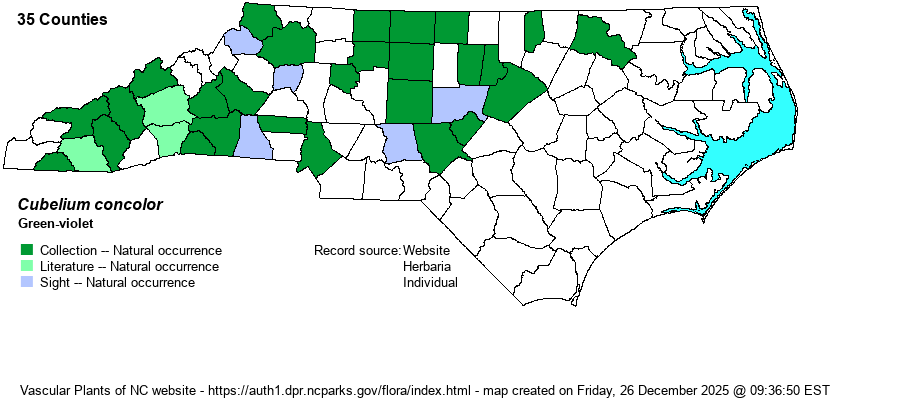| Author | (T.F. Forster) Rafinesque ex Britton & A. Brown | |
| Distribution | Scattered over the Mountains and Piedmont, and barely into the Coastal Plain along the Roanoke River.
This is an Eastern species, ranging from VT and southeastern MN, south to northern FL and eastern OK. | |
| Abundance | Uncommon in the Mountains and upper Piedmont, rare to uncommon in the lower Piedmont, and very rare in the upper Coastal Plain, where known only from Halifax County. In Lee County, a population was re-discovered in 2021, after a hiatus of 63 years. | |
| Habitat | This is a species restricted to high pH soils, over mafic or calcareous rocks, such as amphibolite, gabbro, or limestone. It grows only in rich hardwood forests, mainly on slopes, where it is a characteristic species of Basic Mesic Forests, less so in Rich Cove Forests. |
| Phenology | Blooms from April to early May, and fruits from late May into June. | |
| Identification | This is a fairly coarse herb that grows to about 2 feet on average, rarely almost to 3 feet tall, but often just 1-foot high, at least when beginning to flower. There are numerous alternate leaves on the unbranched stem; each leaf is generally elliptical with an acuminate tip, about 3-4 long long and 1-inch wide. In most leaf axils grow one to a few small pale green to yellow-green flowers, on short but dangling stalks, so that the flower is held below the axil. The flower structure is somewhat complex and difficult to describe, but the gist is a closed-looking flower only about 1/4-inch high that looks like no other flower in NC, as this species is the only one in its genus. The "violet" in the common name is a misnomer; though Cubelium is related to Viola, within the same family (Violaceae), the flower does not resemble a Viola flower in the slightest. To look for this species, you will need to locate a very rich slope, on Iredell or other high pH soil. Even so, if you have never seen the species before, you likely will be puzzled over such an ordinary-looking herb, especially if the small greenish flowers in the axils are not visible. | |
| Taxonomic Comments | Until recently, the species was named as Hybanthus concolor.
| |
| Other Common Name(s) | Eastern Green-violet | |
| State Rank | S3 | |
| Global Rank | G5 | |
| State Status | | |
| US Status | | |
| USACE-agcp | | |
| USACE-emp | | |

